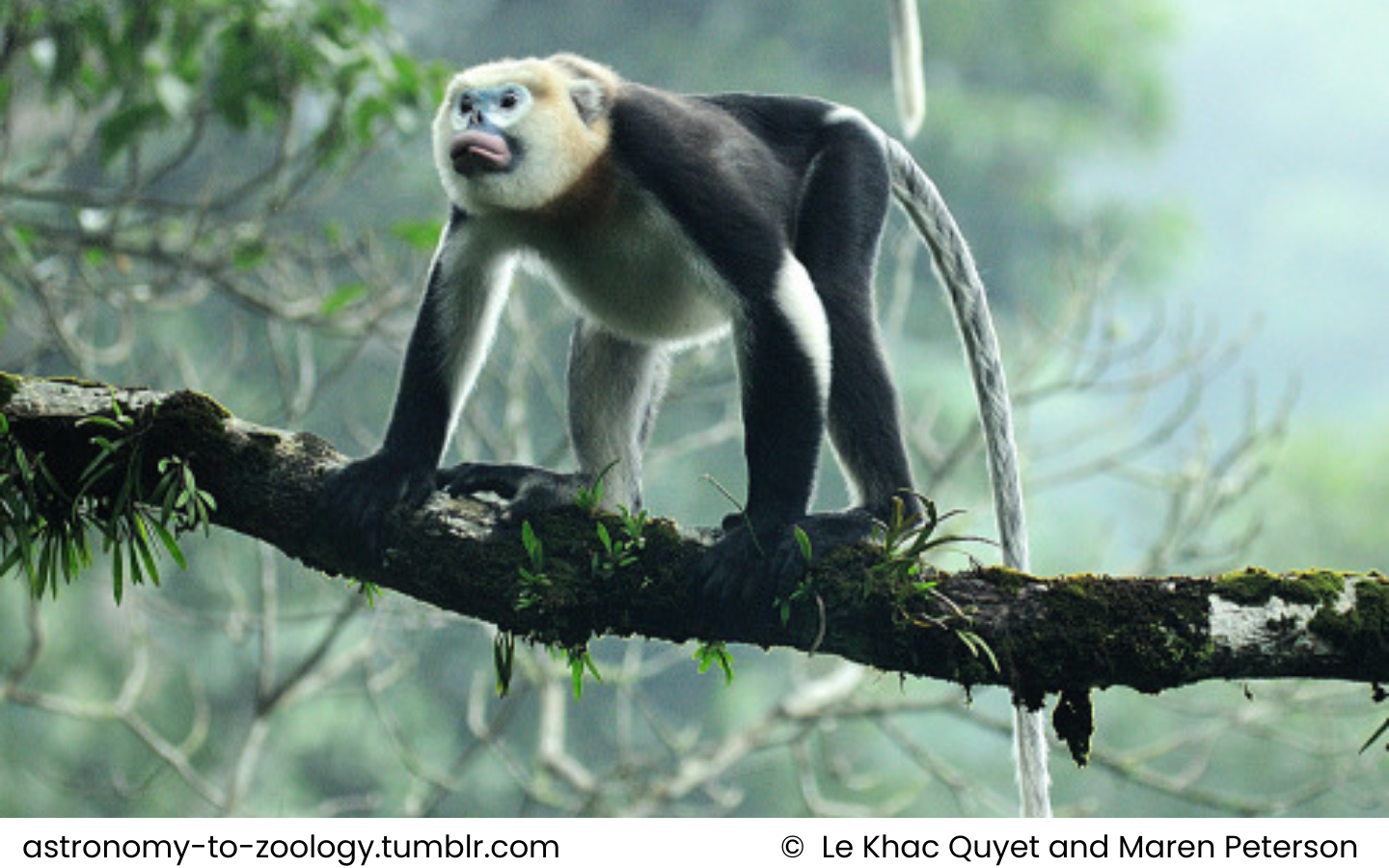
Science name: Rhinopithecus avunculus – Dollman, 1912
Taxonomic: Animalia>> Chordata>> Mammalia>> Primates >> Cercopithecidae >> avunculus
Species status: Endemic ; IUCN status: CR (Critically Endangered Species)
Description:
Physical Characteristics:
Rhinopithecus avunculus is a small, critically endangered monkey with distinctive features. Its fur is black-brown with light-colored fur around the head and face. The body is covered in brown fur with whitish patches on the belly, limbs, and forearms. The species has a long, bushy tail, which exceeds the body length. Newborns have lighter, golden-yellow fur that darkens as they mature.
This monkey does not have a crest of hair on the top of the head, and its face has a distinctive snub-nosed appearance, which gives the species its common name. The large nasal passages are likely an adaptation to the cold, montane environments in which it lives.
Distribution and habitat:
Altitude:
Rhinopithecus avunculus occurs at elevations ranging from 200 to 1,400 meters above sea level.
Range:
This species is endemic to Vietnam, primarily confined to small forest patches in Ha Giang and Tuyen Quang provinces, east of the Red River. It was previously found across a larger area in northeastern Vietnam, but its distribution has become increasingly restricted due to deforestation and hunting. It has been observed in protected areas such as Na Hang Nature Reserve, Khau Ca Forest, and Tung Vai Forest.
Habitat:
The species inhabits tropical evergreen forests associated with karst limestone hills and mountains. It is largely restricted to primary forest but has been recorded in various habitats, including forested mountain tops, valleys, and sometimes bamboo forests. These monkeys sleep in tall trees and are primarily arboreal, rarely coming to the ground. They move and forage mostly in the canopy, helping to avoid competition with other animals.
Behaviour and ecology:
Social Structure:
The Tonkin Snub-nosed Monkey lives in groups characterized by one dominant male and multiple females, often forming social units of 12-15 individuals. Some groups may consist of up to two dozen members. Occasionally, multiple groups join together to form larger temporary bands, although the reasons behind these gatherings are unclear.
Feeding Habits:
These monkeys are highly selective feeders, consuming a variety of plant parts. Their diet includes young and mature leaves, fruits, seeds, flowers, and occasionally shoots of bamboo. They have been recorded to feed on up to 52 plant species, making them essential to forest regeneration.
Reproduction:
Females are known to give birth between March and June. The gestation period is likely around six months, and females typically give birth to a single offspring. Infant monkeys are carried by the mother and are dependent for the first several months of life.
Conservation and status:
IUCN Red List Category and Criteria:
The species is listed as Critically Endangered under criteria A2acd+3cd; C1+2a(i), which means it has experienced a severe population decline, and further declines are expected due to hunting and habitat loss.
Population Trend:
The population is decreasing, with an estimated 80-100 mature individuals remaining. The species is fragmented into 3-5 subpopulations, none of which exceed 30-35 individuals. The most significant population is found in Khau Ca, with approximately 130 individuals, while smaller populations are scattered across other regions.
Threats:
The primary threats to Rhinopithecus avunculus include illegal hunting for traditional medicine, habitat destruction due to deforestation for agriculture (e.g., cardamom farming), and infrastructure development like hydroelectric projects. Population pressures, including increased human settlement and hunting for food, also contribute to their decline. Both legal and illegal logging and gold mining activities are severe threats to their remaining habitats.
Conservation Actions:
The Tonkin Snub-nosed Monkey is protected under Vietnam’s national laws and listed in the Red Data Book of Vietnam. It is also included in the list of species that require immediate conservation action, such as creating and enforcing wildlife protection laws. The species is now protected in several nature reserves, including Na Hang, Cham Chu, and Du Già in Ha Giang province. However, further conservation efforts are necessary to prevent further declines, including expanding protected areas, stricter enforcement of anti-poaching laws, and habitat restoration programs.
Crocodile Trail – The Best Birding Trail in Cat Tien National Park
If you’re a birder or nature photographer planning a trip to Vietnam, few places offer [...]
Cong Troi Trail – Top 1 Dalat Plateau Birding Trail Experience
If you’re a birder or nature photographer planning a trip to Vietnam’s Central Highlands, the [...]
How to Identify the Greater Sand Plover, Tibetan Sand Plover and Siberian Sand Plover
Identification Differences within the Sand Plover Complex: The sand plover group, which was traditionally divided [...]
Highlights of Cat Tien National Park Reptiles and Amphibian Endemics
Spanning over 71,350 hectares of tropical forests, grasslands, and wetlands, Cat Tien National Park is [...]
Highlights of Cat Tien National Park Mammals in a World Biosphere Reserve
In addition to reptiles and birds, Cat Tien National Park is also rich in mammals, [...]
Kontum Plateau Endemic and Highlight bird
Kontum Plateau Endemic And Highlight Bird species like Chestnut-eared Laughingthrush and top birding routes while [...]